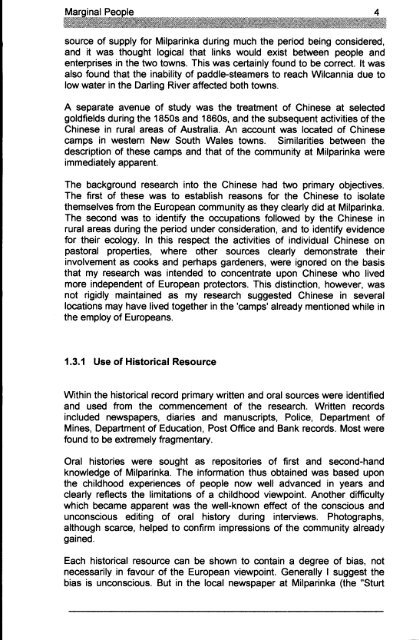Adec Preview Generated PDF File - The Sydney eScholarship ...
Adec Preview Generated PDF File - The Sydney eScholarship ...
Adec Preview Generated PDF File - The Sydney eScholarship ...
You also want an ePaper? Increase the reach of your titles
YUMPU automatically turns print PDFs into web optimized ePapers that Google loves.
source of supply for Milparinka during much the period being considered,<br />
and it was thought logical that links would exist between people and<br />
enterprises in the two towns. This was certainly found to be correct. It was<br />
also found that the inability of paddle-steamers to reach Wilcannia due to<br />
low water in the Darling River affected both towns.<br />
A separate avenue of study was the treatment of Chinese at selected<br />
goldfields during the 1850s and 1860s, and the subsequent activities of the<br />
Chinese in rural areas of Australia. An account was located of Chinese<br />
camps in western New South Wales towns. Similarities between the<br />
description of these camps and that of the community at Milparinka were<br />
immediately apparent.<br />
<strong>The</strong> background research into the Chinese had two primary objectives.<br />
<strong>The</strong> first of these was to establish reasons for the Chinese to isolate<br />
themselves from the European community as they clearly did at Milparinka.<br />
<strong>The</strong> second was to identify the occupations followed by the Chinese in<br />
rural areas during the period under consideration, and to identify evidence<br />
for their ecology. In this respect the activities of individual Chinese on<br />
pastoral properties, where other sources clearly demonstrate their<br />
involvement as cooks and perhaps gardeners, were ignored on the basis<br />
that my research was intended to concentrate upon Chinese who lived<br />
more independent of European protectors. This distinction, however, was<br />
not rigidly maintained as my research suggested Chinese in several<br />
locations may have lived together in the 'camps' already mentioned while in<br />
the employ of Europeans.<br />
1.3.1 Use of Historical Resource<br />
Within the historical record primary written and oral sources were identified<br />
and used from the commencement of the research. Written records<br />
included newspapers, diaries and manuscripts, Police, Department of<br />
Mines, Department of Education, Post Office and Bank records. Most were<br />
found to be extremely fragmentary.<br />
Oral histories were sought as repositories of first and second-hand<br />
knowledge of Milparinka. <strong>The</strong> information thus obtained was based upon<br />
the childhood experiences of people now well advanced in years and<br />
clearly reflects the limitations of a childhood viewpoint. Another difficulty<br />
which became apparent was the well-known effect of the conscious and<br />
unconscious editing of oral history during interviews. Photographs,<br />
although scarce, helped to confirm impressions of the community already<br />
gained.<br />
Each historical resource can be shown to contain a degree of bias, not<br />
necessarily in favour of the European viewpoint. Generally I suggest the<br />
bias is unconscious. But in the local newspaper at Milparinka (the "Sturt




